NCERT Exemplar Class 11 Maths Chapter 10 Straight Lines are part of NCERT Exemplar Class 11 Maths . Here we have given NCERT Exemplar Class 11 Maths Chapter 10 Straight Lines.
NCERT Exemplar Class 11 Maths Chapter 10 Straight Lines
Short Answer Type Questions
Q1. Find the equation of the straight line which passes through the point (1, -2)

Q2. Find the equation of the line passing through the point (5,2) and perpendicular to the line joining the points (2, 3) and (3, -1)
Sol:
We have points A(5, 2), B(2, 3) and C(3, -1).
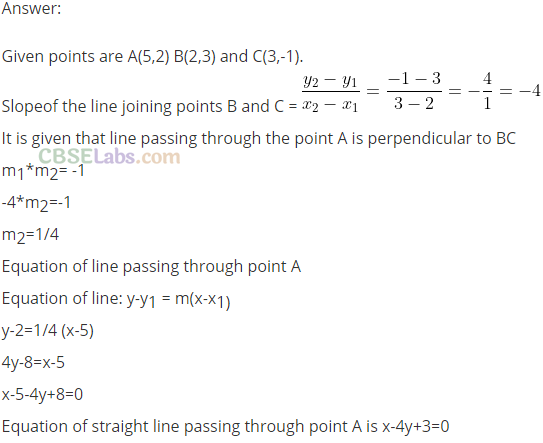
Q3. Find the angle between the lines y = (2 -√3) (x + 5) and y = (2 + -√3) {x – 7)
Sol:
Slope of the line = (2 -√3)(x + 5) is: m
l
= (2 -√3 )
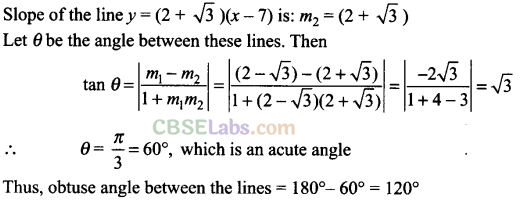
Q4. Find the equation of the lines which passes through the point (3, 4) and cuts off intercepts from the coordinate axes such that their sum is 14.
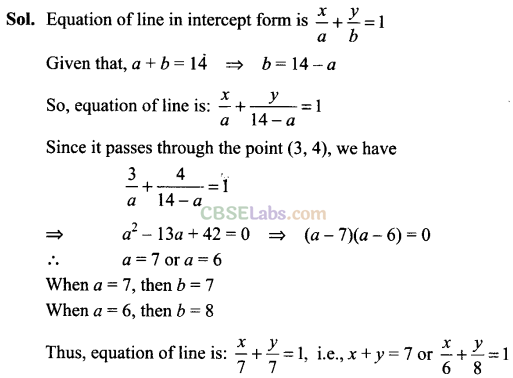
Q5. Find the points on the line x+y = 4 which lie at a unit distance from the line 4x + 3y= 10
Sol.
Let the required point be (h, k) lies on the line x + y = 4
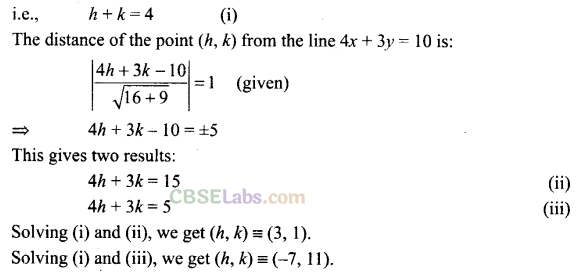
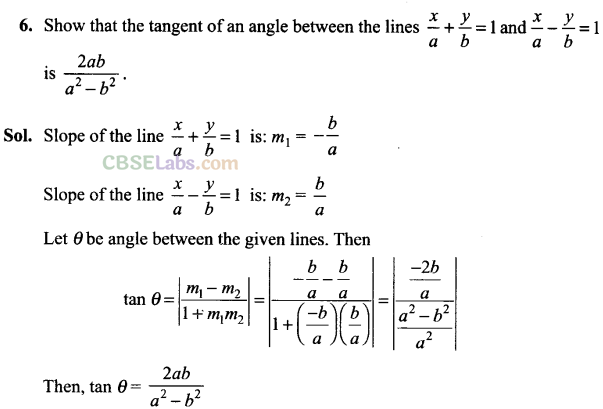
Q7. Find the equation of lines passing through (1,2) and making angle 30° with
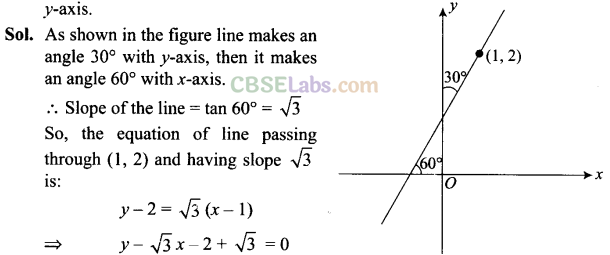
Q8. Find the equation of the line passing through the point of intersection of lx + y = 5 and x + 3 y +8 = 0 and parallel to the line 3x + 4y = 1.
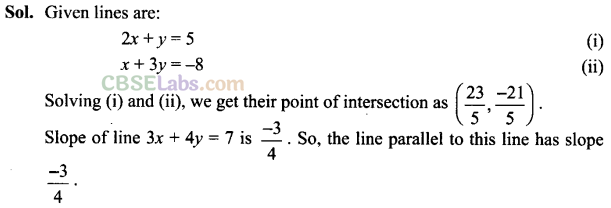
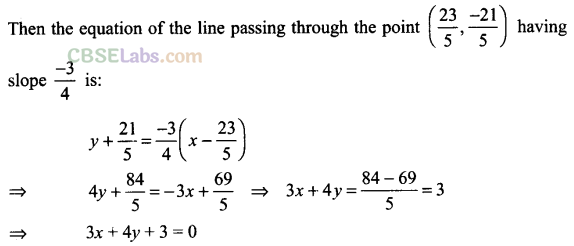
Q9. For what values of a and b the intercepts cut off on the coordinate axes by the line ax + by + 8 = 0 are equal in length but opposite in signs to those cut off by the line 2x – 3y + 6 = 0 on the axes.
Sol:
Given line is:
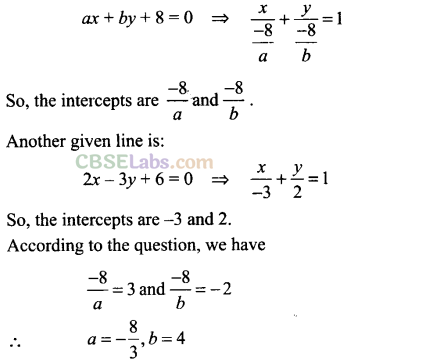
Q10. If the intercept of a line between the coordinate axes is divided by the point (-5,4) in the ratio 1 : 2, then find the equation of the line.
Sol:
Let the line through the point P(-5, 4) meets axis at A(h, 0) and B(0, k)
According to the question, we have AP: BP =1:2
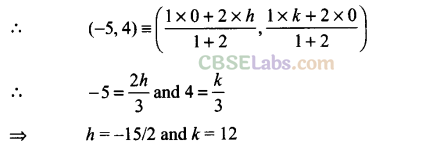

Q11. Find the equation of a straight line on which length of perpendicular from the origin is four units and the line makes an angle of 120° with the positive direction of x-axis.
Sol:
Given that the line makes and angle 120° with positive direction of x-axis.
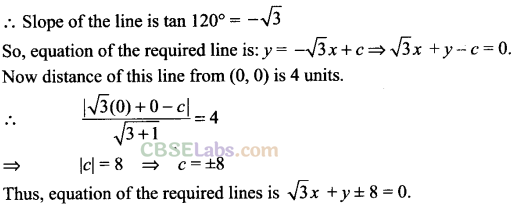
Q12. Find the equation of one of the sides of an isosceles right angled triangle whose hypotenuse is given by 3x + Ay = 4 and the opposite vertex of the hypotenuse is (2, 2).
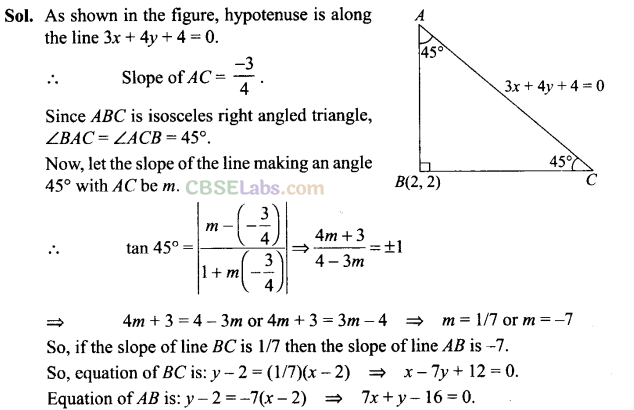
Long Answer Type Questions
Q13. If the equation of the base of an equilateral triangle is x + y – 2 and the vertex is (2, -1), then find the length of the side of the triangle.
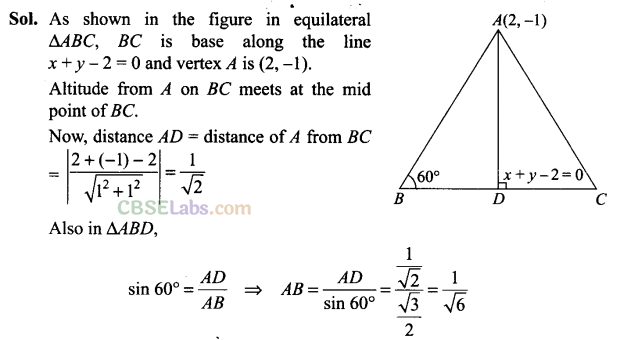
NCERT
Q14. A variable line passes through a fixed point P. The algebraic sum of the perpendiculars drawn from the points (2, 0), (0, 2) and (1, 1) on the line is zero. Find the coordinates of the point P
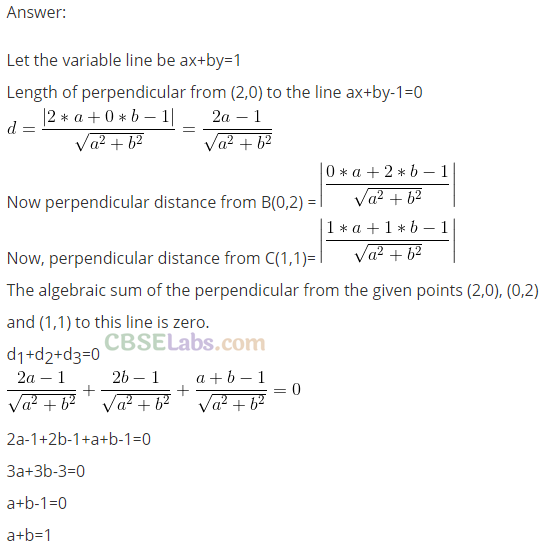

Q15. In what direction should a line be drawn through the point (1, 2) so that its point of intersection with the line x+y = 4 is at a distance √6/3 from the given point.

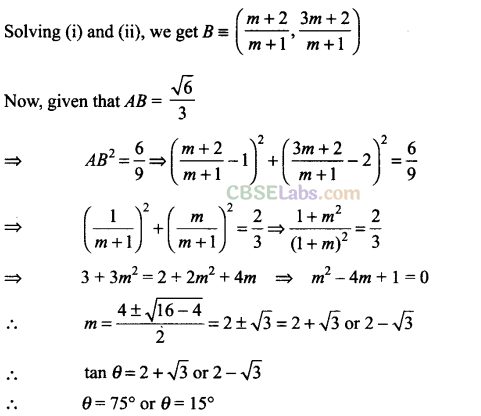
Q16. A straight line moves so that the sum of the reciprocals of its intercepts made on axes is constant. Show that the line passes through a fixed point.
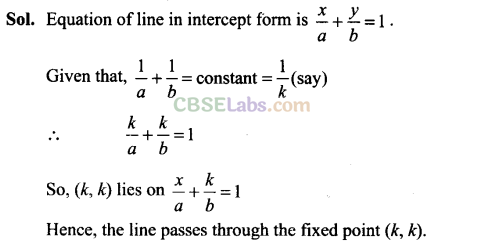
Q17. Find the equation of the line which passes through the point (-4, 3) and the portion of the line intercepted between the axes is divided internally in the ratio 5 : 3 by this point.
Sol:
Let the line through the point P(-A, 3) meets axis at A(h, 0) and 0(0, k)
Now according to the question AP : BP =5:3
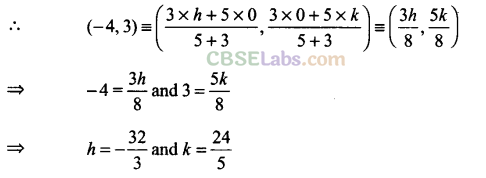

Q18. Find the equations of the lines through the point of intersection of the lines x-y+ 1=0 and 2x – 3y + 5 = 0 and whose distance from the point (3, 2) is 7/5
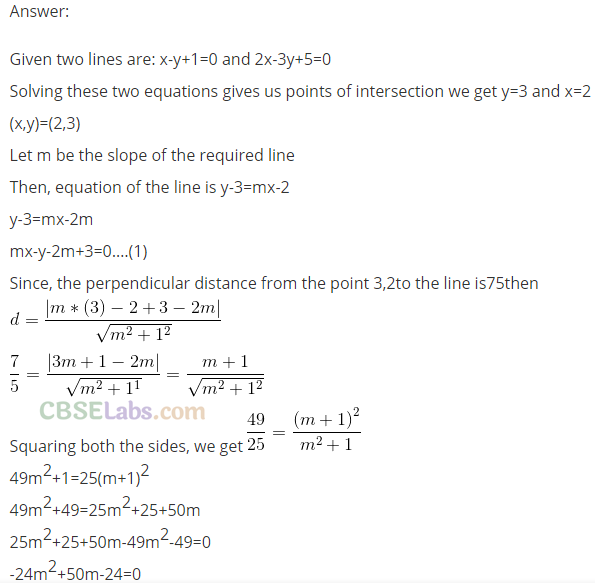
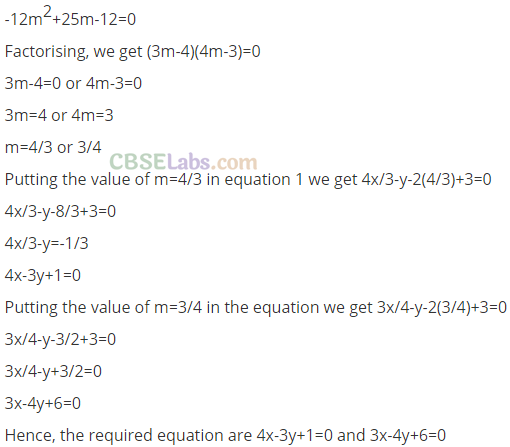
Q19. If the sum of the distances of a moving point in a plane from the axes is 1, then find the locus of the point.
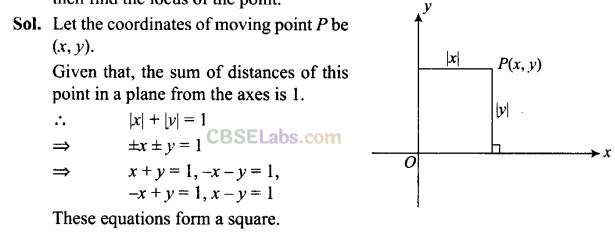
Q20. P
l,
P
2
are points on either of the two lines y — √3 |x| = 2 at a distance of 5 units from their point of intersection. Find the coordinates of the foot of perpendiculars drawn from P
1
, P
2
on the bisector of the angle between the given lines.
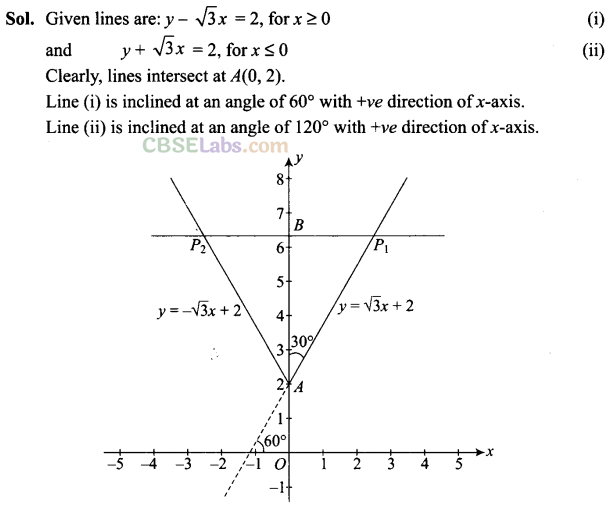
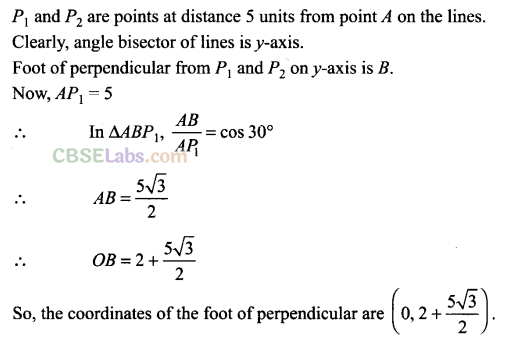
Q21. If p is the length of perpendicular from the origin on the line \(\frac { x }{ a } +\quad \frac { y }{ b } \) and a
2
,p
2
and are in the A.P , then show that a
4
+b
4
= 0
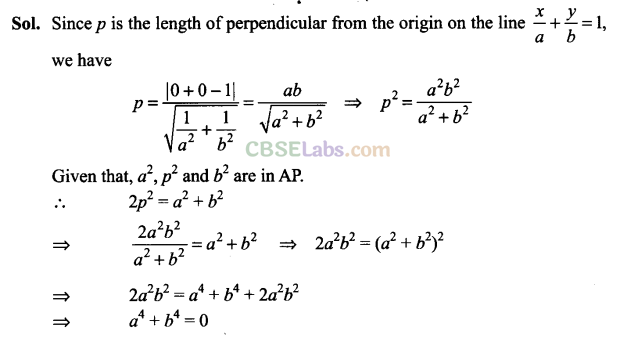
Objective Type Questions
Q22. A line cutting off intercept -3 from the y-axis and the tangent of angle to the x-axis is 3/5, its equation is
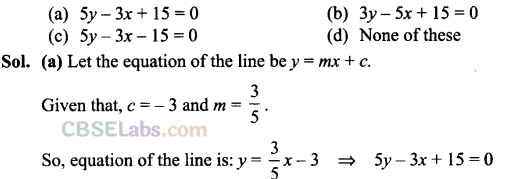
Q23. Slope of a line which cuts off intercepts of equal lengths on the axes is
(a) -1
(b) 0
(c) 2
(d) √3
Sol: (a) Equation of the according to the question is \(\frac { x }{ a } +\quad \frac { y }{ a } \)
=>
x+y = a
Required slope = -1
Q24. The equation of the straight line passing through the point (3, 2) and perpendicular to the line y = x is
(a) x-y = 5
(b) x+y = 5
(c)x+y=l
(d)x-y=1
Sol
:(b) Slope of the given line y = x is 1.
Thus, slope of line perpendicular to y = x is -1.
Line passes through the point (3, 2).
So, equation of the required line is:y-2=-l (x – 3) => x + y = 5
Q25. The equation of the line passing through the point (1,2) and perpendicular to the line x +y + 1 = 0 is
(a) y-x +1=0
(b) y — x—1=0
(c) y-x + 2 = 0
(d) y — x — 2=0
Sol:
(b) Slope of the given line +1=0 is-1.
So, slope of line perpendicular to above line is 1.
Line passes through the point (1,2).
Therefore, equation of the required linens:
y-2 = 1(x- 1) => y-x-1=0.
Q26. The tangent of angle between the lines whose intercepts on the axes are a, -b and b, -a, respectively, is
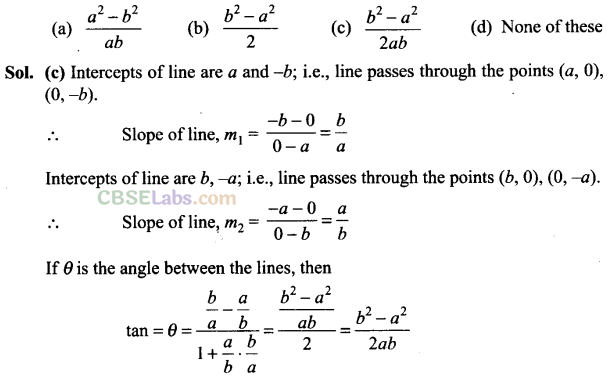
Q27. If the line \(\frac { x }{ a } +\frac { y }{ b } \) passes through the points (2, -3) and (4, -5), then (a, b) a b is
(a) (1,1)
(b) (-1,1)
(c) (1,-1)
(d) (-1,-1)
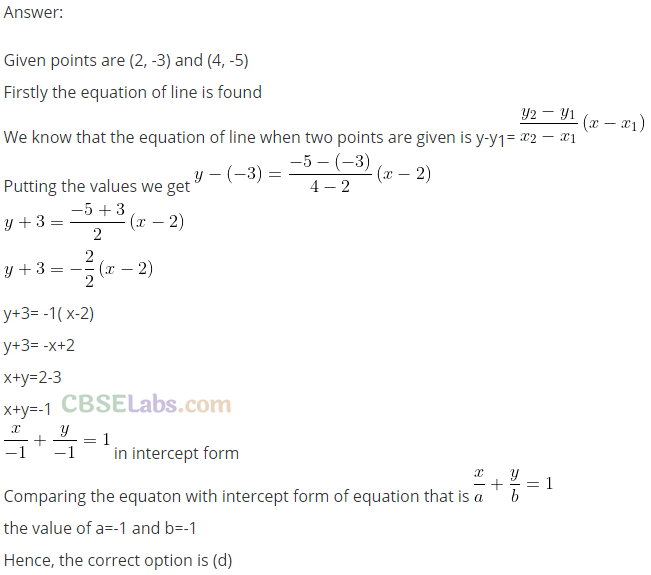
Q28. The distance of the point of intersection of the lines 2x – 3y + 5 = 0 and 3x + 4y = 0 from the line 5x – 2y = 0 is
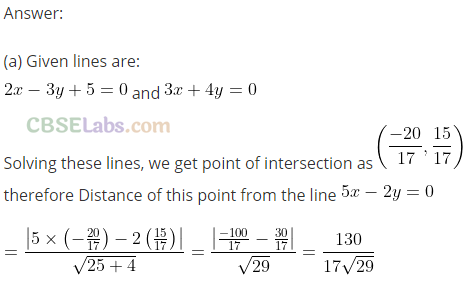
Q29. The equations of the lines which pass through the point (3, -2) and are inclined at 60° to the line √3 x + y = 1 is
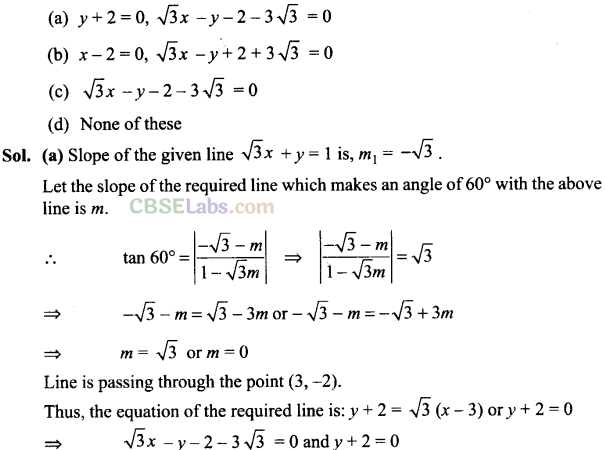
Q30. The equations of the lines passing through the point (1,0) and at a distance √3/2 from the origin, are
![]()
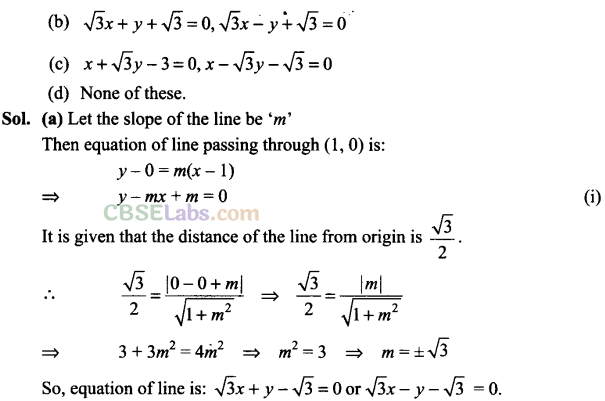
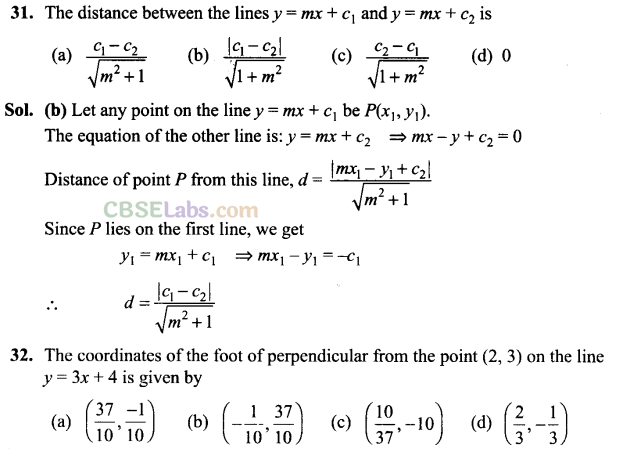
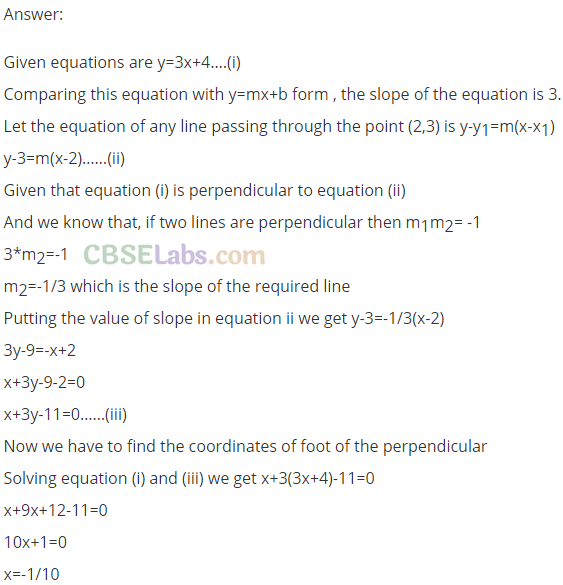
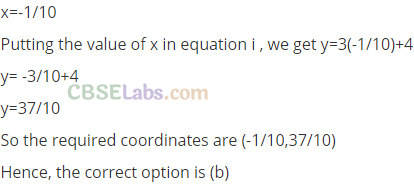
Q33. If the coordinates of the middle point of the portion of a line intercepted between the coordinate axes is (3, 2), then the equation of the line will be
(a) 2x + 3y = 12
(b) 3x + 2y=l2
(c) 4x-3y = 6
(d) 5x- 2y=10
Sol:
(a) Since, the middle point is P(3, 2), then line meets axes at A(6, 0) and B (0, 4).
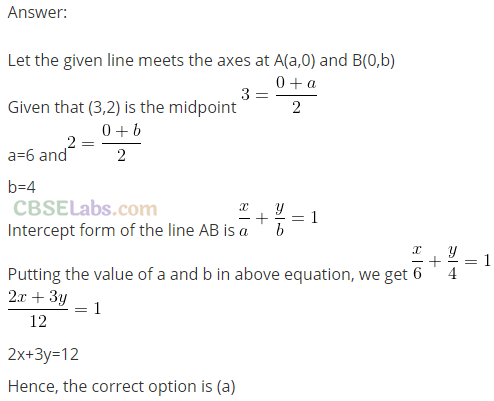
Q34. Equation of the line passing through (1,2) and parallel to the line y = 3x – 1 is
(a)y + 2=x+l
(b) y + 2 = 3(x + 1)
(c) y -2 = 3(x — 1)
(d) y-2=x-l
Sol:
(c) Line is parallel to the line y = 3x – 1.
So, slope of the line is‘3’.
Also, line passes through the point (1,2).
So, equation of the line is: y – 2 = 3(x – 1)
Q35. Equations of diagonals of the square formed by the lines x = 0, y = 0, x = 1 and y = 1 are
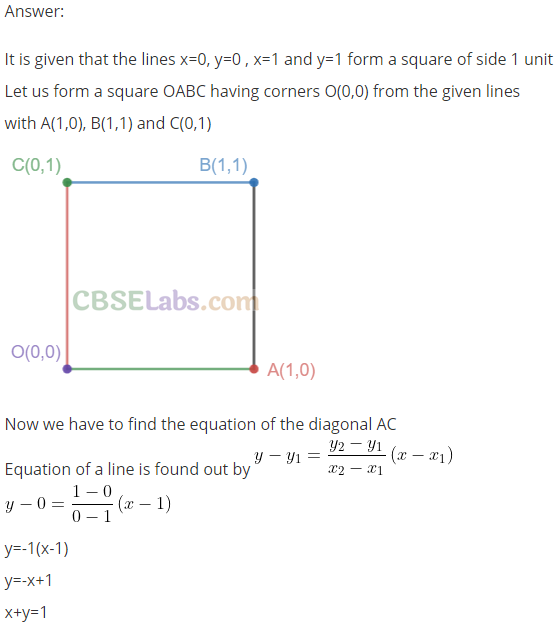
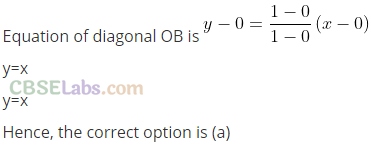
Q37. The point (4, 1) undergoes the following two successive transformations:
(i) Reflection about the line y = x
(ii) Translation through a distance 2 units along the positive x-axis Then the final coordinates of the point are
(a) (4,3)
(b) (3,4)
(c) (1,4)
(d) (7/2,7/2)
Sol:
(b) Reflection of A (4, 1) in y = x is 5(1,4).
Now translation of point B through a distance ‘2’ units along the positive x-axis shifts B to C( 1 + 2,4) or C(3,4).
Q38. A point equidistant from the lines 4x + 3y+ 10 = 0, 5x – 12y + 26 = 0 and lx + 24y – 50 = 0 is
(a) (1,-1)
(b) (1, 1)
(c) (0,0)
(d) (0, 1)
Sol:
(c) Clearly distance of each of three lines from (0, 0) is 2 units.
Q39. A line passes through (2, 2) and is perpendicular to the line 3x + y = 3. Its y-intercept is
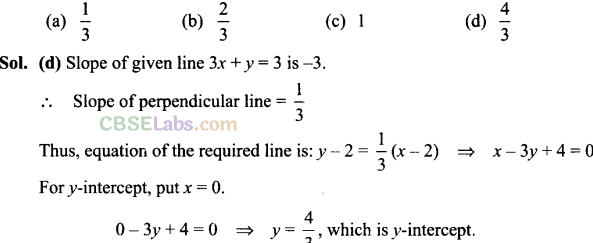
Q40. The ratio in which the line 3x + 4y + 2 = 0 divides the distance between the lines 3x + 4y + 5 = 0 and 3x + 4y – 5 = 0 is
(a) 1:2 (b) 3:7 (c) 2:3 (d) 2:5
Sol:
(b) Given lines are:
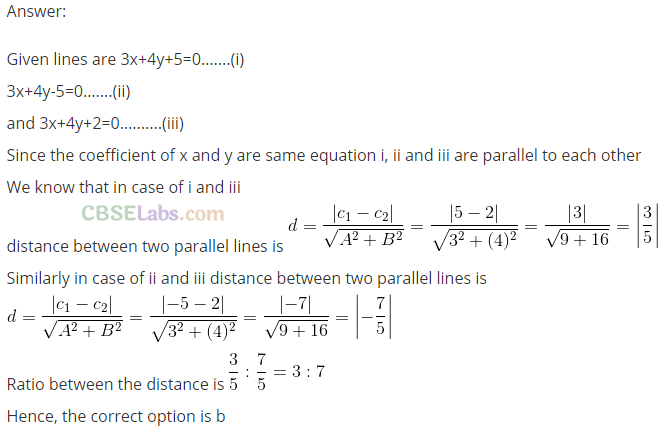
Q41. One vertex of the equilateral triangle with centroid at the origin and one side asx + y- 2 = 0is
(a) (-1,-1) (b) (2,2) (c) (-2,-2) (d) (2,-2)
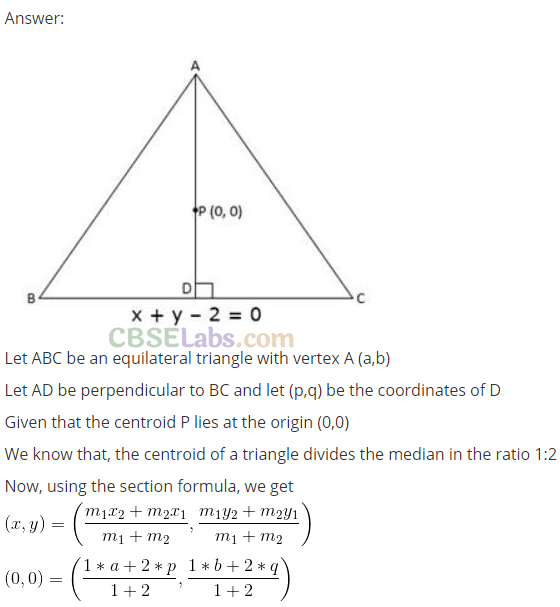
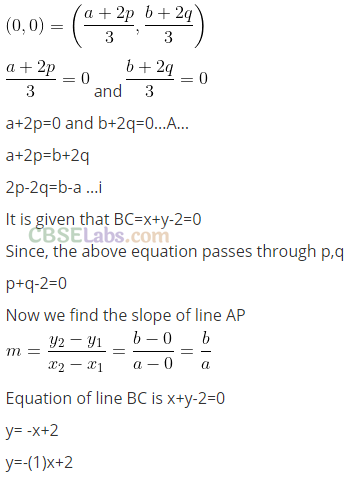
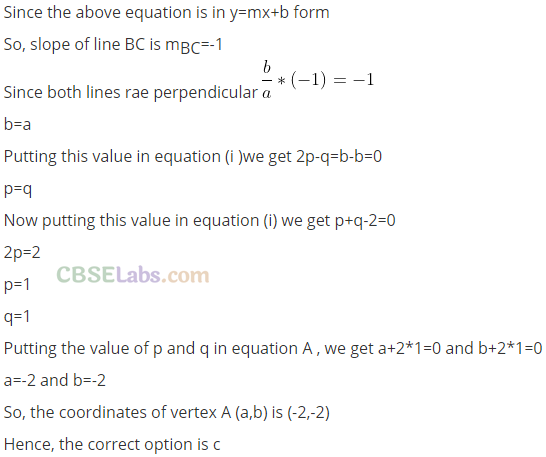
Fill in the Blanks Type Questions
Q42. If a, b, c are in A.P., then the straight lines ax + by + c = 0 will always pass through __________

Q43.The line which cuts off equal intercept from the axes and pass through the point (1, -2) is
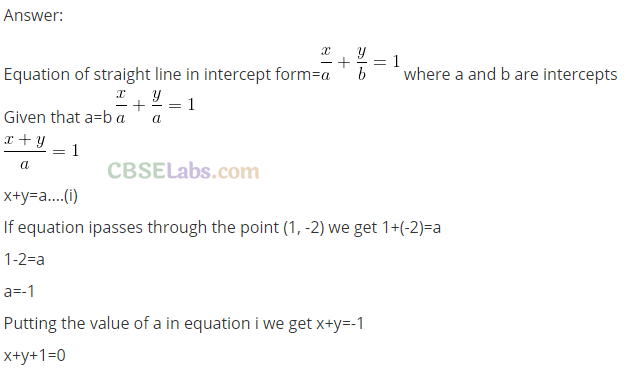
Q44. Equations of the lines through the point (3, 2) and making an angle of 45° with the line x – 2y = 3 are _____
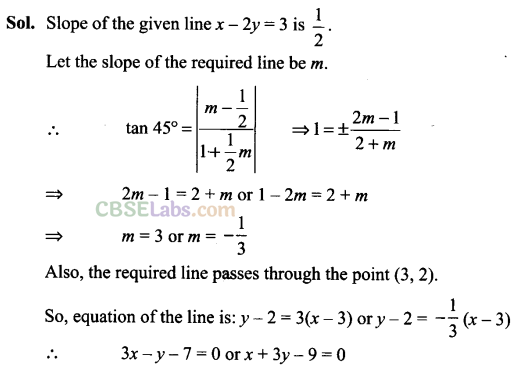
Q45. The points (3,4) and (2, -6) are situated on the_____ of the line 3x – 4y – 8= 0.
Sol:
Given line is 3x – 4y – 8 = 0
For point (3, 4), 3(3) – 4(4) – 8 = -15 < 0
For point (2, -6), 3(2) – 4(—6) – 8 = 22 > 0
Hence, the points (3,4) and (2, -6) lies on opposite side of the line.
Q46. A point moves so that square of its distance from the point (3, -2) is numerically equal to its distance from the line 5x – 12y = 3. The equation of its locus is______ .
Sol
: Let the moving point be P(h, k).
Given point is A(3, -2).
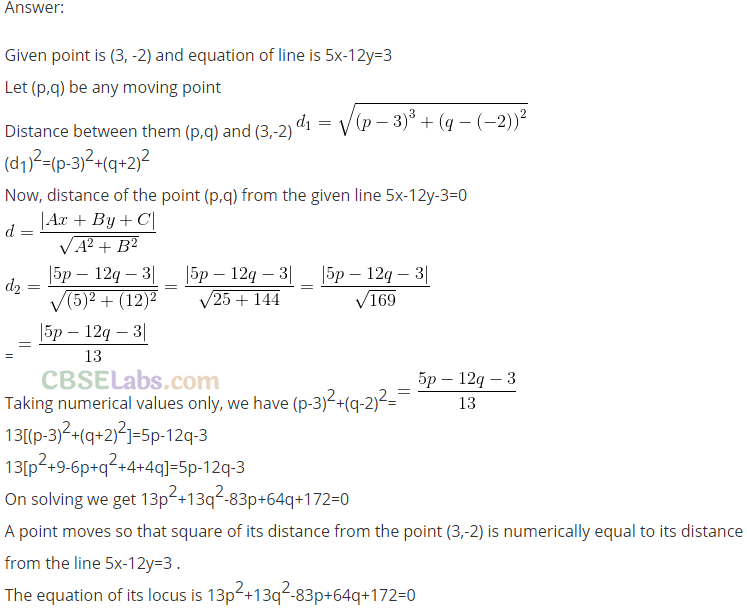
Q47. Locus of the mid-points of the portion of the line x sin θ + y cos θ = p intercepted between the axes is ______
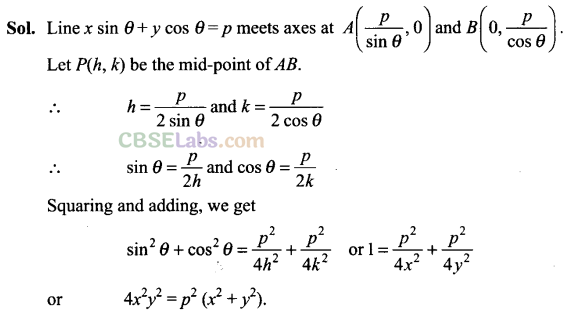
True/False Type Questions
Q48. If the vertices of a triangle have integral coordinates, then the triangle can not be equilateral.
Sol:
True
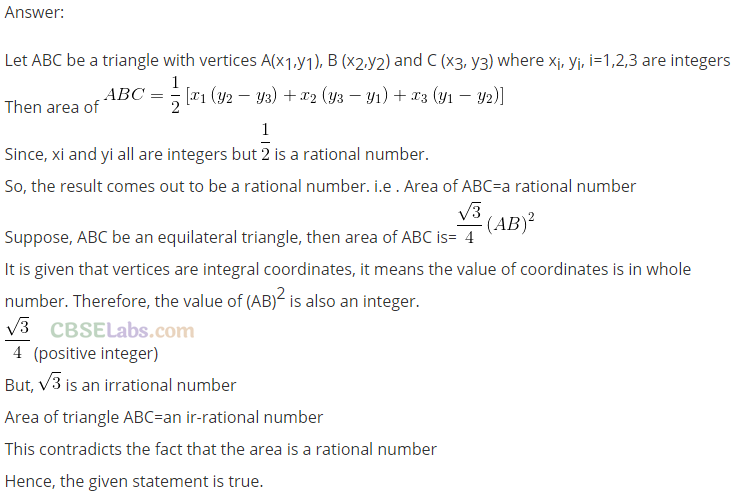
This is a contradiction to the fact that the area is a rational number. Hence, the triangle cannot be equilateral.
Q49. The points A(-2, 1), B(0, 5), C(-l, 2) are collinear.
Sol:
False
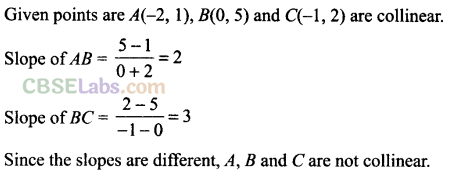
Q50. Equation of the line passing through the point (a cos
3
, a sin
3
) and perpendicular to the line
x sec + y cosec = a isx cos -y sin = a sin 2
Sol:
False
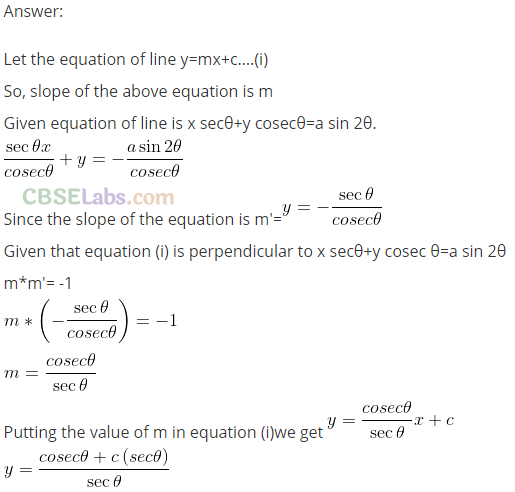
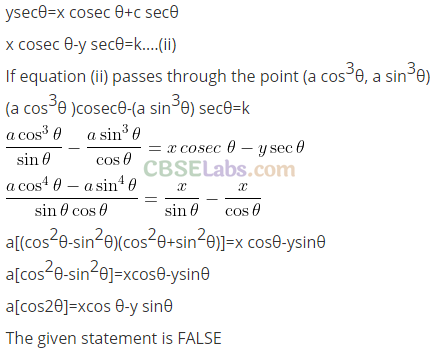
Q51. The straight line 5x + 4y = 0 passes through the point of intersection of the straight lines x + 2y— 10 = 0 and 2x +y + 5 = 0
.
Sol:
True
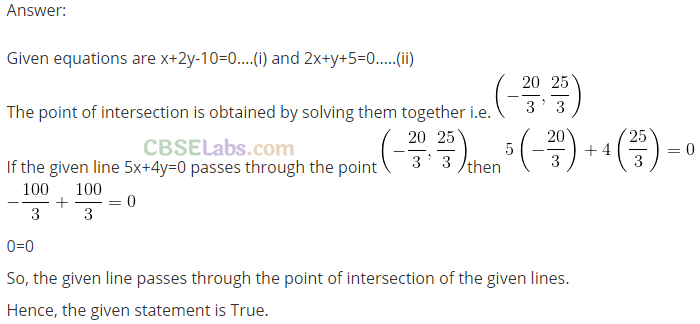
Q53. The equation of the line joining the point (3, 5) to the point of intersection of the lines 4x +y – 1 = 0 and lx – 3v – 35 = 0 is equidistant from the points (0, 0) and (8, 34).
Sol:
True
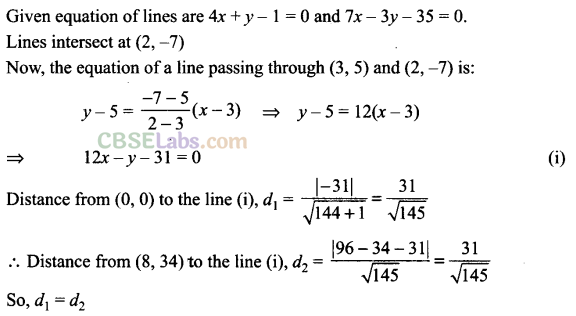
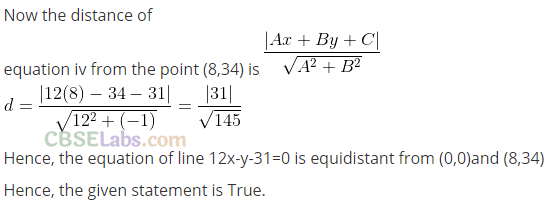

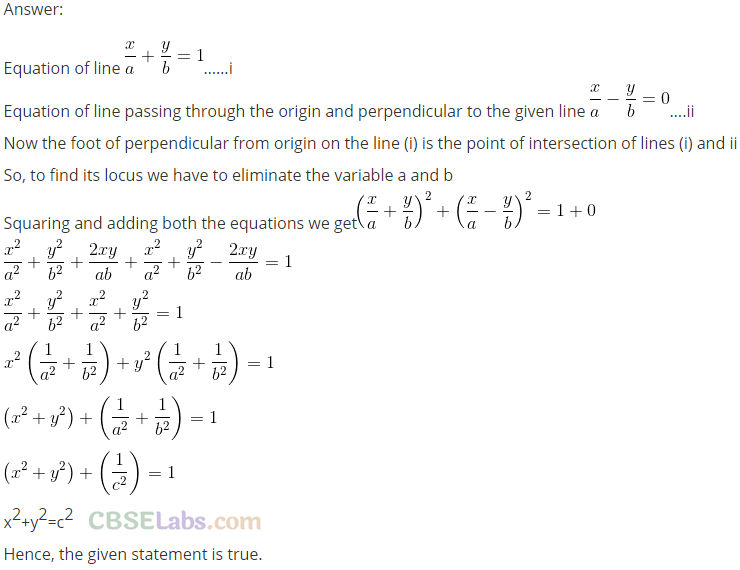
Q55. The line ax + 2y + 1 = 0, bx + 2y + 1 = 0 and cx + 4y + 1 = 0 are concurrent, if a, b and c are in GP.
Sol:
False
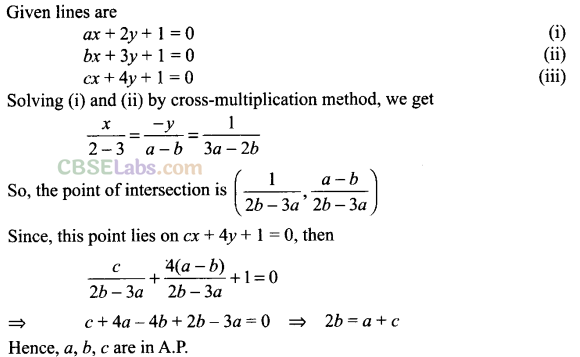
Q56. Line joining the points (3, -4) and (-2, 6) is perpendicular to the line joining the points (-3, 6) and (9, -18).
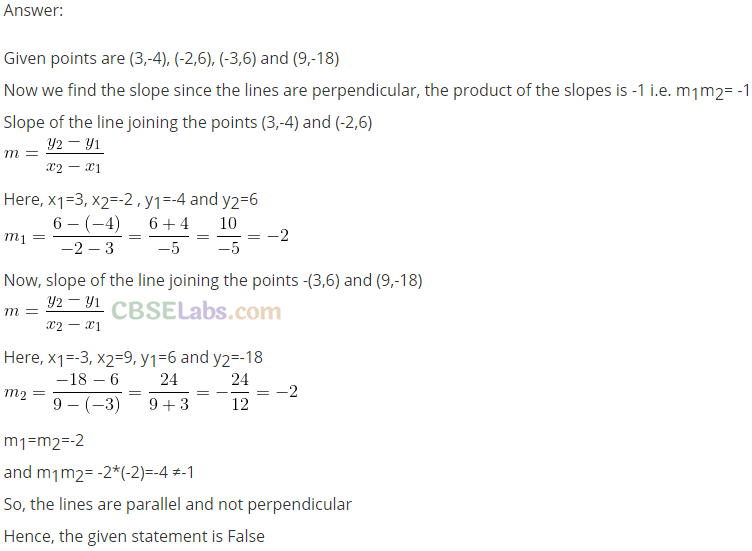
NCERT Exemplar Class 11 Maths Solutions
- Chapter 1 Sets
- Chapter 2 Relations and Functions
- Chapter 3 Trigonometric Functions
- Chapter 4 Principle of Mathematical Induction
- Chapter 5 Complex Numbers and Quadratic Equations
- Chapter 6 Linear Inequalities
- Chapter 7 Permutations and Combinations
- Chapter 8 Binomial Theorem
- Chapter 9 Sequence and Series
- Chapter 10 Straight Lines
- Chapter 11 Conic Sections
- Chapter 12 Introduction to Three-Dimensional Geometry
- Chapter 13 Limits and Derivatives
- Chapter 14 Mathematical Reasoning
- Chapter 15 Statistics
- Chapter 16 Probability